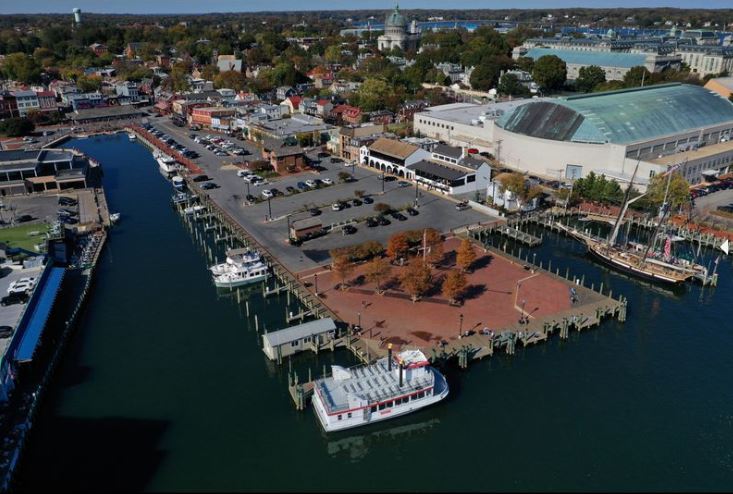In May 2020, the shortened Maryland 2020 General Assembly Session passed Senate Bill 457, which authorizes local governments in the area to establish Resilience Authorities. The first of its kind, the bill enables a local jurisdiction to flexibly organize funding structures for, and manage, large-scale infrastructure projects specifically aimed at addressing the effects of climate change[1]. The Bill allows local governments to establish and fund Resilience Authorities under local law, outlines the requirements to do so, and stipulates the powers local governments may, and may not, grant to their Resilience Authority.
The Maryland Senate Bill was passed with a bipartisan vote on May 8, 2020. It was supported by Democrats and Republicans on both sides of the Chesapeake Bay. Senator Sarah Elfreth (District 30) sponsored the bill, stating that, “The bill ensures Maryland remains a national leader in preparing ourselves for the impending crisis presented by climate change and sea-level rise.[2]” Annapolis mayor Gavin Buckley and Anne Arundel County Executive Steuart Pittman championed the bill, and Maryland Governor Larry Hogan allowed the bill to go into effect without his signature.

Sarah Elfreth, D-Annapolis, (right) introduced her resiliency fund legislation alongside Del. Shaneka Henson, D-Annapolis, (left to right), Del. Brooke Lierman, D-Baltimore City, Del. Courtney Watson, D-Howard County, and Del. Stephanie Smith, D-Baltimore City, all who were supporting similar climate legislation. (Olivia Sanchez).
Resilience Authorities were created for areas with significant shoreline that need a flexible, efficient way to fund resilience infrastructure projects. Without these authorities, these projects would be nearly impossible to fund for communities with a strong aversion to new taxes. Resilience Authorities provide structure for local governments seeking to address climate change in their communities through resiliency projects, but puts the power in local leaders’ hands to decide how to pay for the projects. Resilience Authority projects are aimed at addressing the effects of climate change, including sea-level rise, flooding, increased precipitation, erosion, and heatwaves. Funds from these authorities may be used to support many types of resilience operations and infrastructure projects, including developing flood barriers, green spaces, and stormwater infrastructure and elevating buildings[1].
The following paragraphs detail the provisions of the Resilience Authority law.
- The first provision provides a nonexclusive list of projects that local governments can utilize to adapt to localized climate-change related issues. It states that a Resilience Authority can use any powers, except eminent domain, that are necessary to manage, acquire, or support infrastructure projects, including constructing, altering, or operating such infrastructure[1].
- Second, the law gives Resilience Authorities the ability to draw on a range of funding options for resiliency projects. Resilience Authorities may charge and collect non-tax related fees, issue or sell state or local tax-exempt bonds, and utilize local, state, nonprofit funding to provide capital for projects. They may also combine any of these funding mechanisms. However, Resilience Authorities are not permitted to levy any taxes to provide for resiliency project funding. This second provision in the bill gives Resilience Authorities quite a bit of flexibility in deciding how to fund resiliency infrastructure projects.
- Local governments are given the authority to make decisions surrounding staffing and employment, and the budgetary and financial procedures of the Resilience Authority.
- In addition, Resilience Authorities are not restricted to a single county. These authorities can be created by a single local government, but can also include more than one county. This would allow for infrastructure investments to facilitate climate adaptation on a regional scale.
- Lastly, the bill stipulates that a Resilience Authority must provide an annual report to its local government, as well as the State Senate and Taxation Committee, and the Senate Education, Health, and Environmental Affairs Committee. This report must include a description of the infrastructure projects, and the Authority’s sources of funding.
Currently, Charles County and Anne Arundel Counties have begun the process of establishing Resilience Authorities in Maryland. According to Joanne Throwe, President of Throwe Environmental, “Charles County, MD is ahead of the game and planning to fund some nuisance flooding projects in priority areas within the county as soon as they can, although nothing has been funded yet. They are still in the early stages of setting up their board.” Additionally, Throwe stated “Anne Arundel County, MD is getting ready to introduce their local bill to authorize an authority in March and we hope to see that pass as easily and as quickly as Charles County’s did.” All local governments within the state are authorized to establish Resilience Authorities; we can expect more established Resilience Authorities in the near future.
So why Resilience Authorities? What is the significance of their passage into law in Maryland? According to Adaptation Clearinghouse, communities in coastal states account for nearly half of the nation’s population and economic activity, and that cumulative damage to property in those areas could reach $3.5 trillion by 2060[1]. Local governments are feeling the effects of climate change more and more each year, and Resilience Authorities give these local jurisdictions the power to create their own, personalized projects to combat these issues in their areas. The Authorities make the process of planning, funding, and completing resiliency projects much quicker, and efficient for local governments, since they are able to bypass the state and federal red tape that usually confines these types of projects. Joanne Throwe stated that, “Resilience Authorities are the next step in providing local governments with the much needed capacity to effectively invest scarce fiscal resources. Authorities are long term tools that can help deal with the long term impacts to our local infrastructure.”
As far of the future of Resilience Authorities, Annapolis, Maryland is planning to use a Resilience Authority to help pay for an estimated $50 million worth of planned renovations to City Dock, the historic heart of Annapolis that hosts some of the city’s biggest events as well as many bars & restaurants. Annapolis Mayor Gavin Buckley is aiming to create waves throughout the country with the city’s use of a Resilience Authority; “As the state capital of Maryland, Annapolis is going to lead the way in this stuff – We’re trying to be the resiliency capital of the country.[2]” Anne Arundel County Executive Steuart Pittman says, “Anne Arundel County is on the frontline of the battle against sea-level rise. In fact, we have 530 miles of that front line in the form of our coast. The finance authority that this bill allows will ultimately save our taxpayers money, protect our communities, and contribute to our efforts to Build Back Better.[3]”
The photos below compare an aerial shot of City Dock as it is now (top), contrasted with a rendering of the improvements (bottom).


Since Resilience Authorities are a new climate adaptation strategy, and are so far only Maryland law, we will provide updates about any incoming Resilience Authority projects or authorizations in other jurisdictions.
Sources:
[1] https://www.adaptationclearinghouse.org/resources/maryland-senate-bill-457-resilience-authorities.html
[2] https://www.capitalgazette.com/politics/ac-cn-resiliency-bill-20200131-20200203-pifc2k6iy5fo3bfaqnv2rbt4dy-story.html
[3] https://www.capitalgazette.com/politics/ac-cn-resiliency-bill-20200131-20200203-pifc2k6iy5fo3bfaqnv2rbt4dy-story.html





Leave a Reply